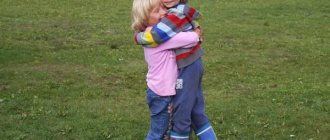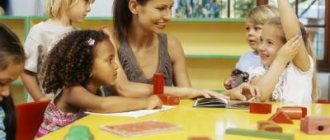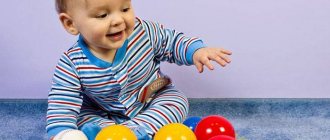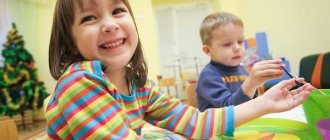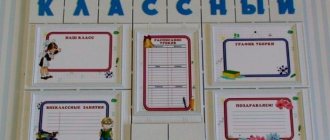Anatomical and physiological characteristics
Let's consider the main indicators of physical development:
- height 96 cm + 4 cm;
- weight 12 kg + 1 kg;
- number of teeth - 20 pcs. (all dairy).
The volume of the skull of a three-year-old child is 4/5 of the volume of the skull of an adult. The baby's spine and bones are still quite soft and, under certain conditions, can be deformed. Therefore, it is necessary to monitor the child’s posture and the condition of the joints.
Certain features are noticeable in muscle development. Large muscles are more developed, so the baby is better able to perform movements with the whole arm. He gradually learns to control his entire body (bends, turns, raises his arms, sways). Such exercises should be included in daily physical education. In general, at this age children have an increased need for physical activity.
Also, at 3-4 years old, there is an increased development of fine motor skills and coordination of movements. This is facilitated by modeling, drawing and other types of visual activities, which are an obligatory component of various didactic games and cognitive activities of younger preschoolers. In this way, the child improves his ability to control the movements of his fingers and hand.
The cardiovascular and respiratory systems develop according to the needs of the growing body. There are certain problems with the ability to consciously regulate breathing. Therefore, children should be given exercises with fluff, balloons, and light paper products, during which they should exhale in a controlled manner.
Development of the central nervous system
The central nervous system of a three-year-old child continues to improve. This is expressed as follows:
- the ability to analyze and synthesize information that comes from the environment appears;
- speech develops, its role in the process of cognition increases (the baby asks questions, questions and clarifies);
- Children are able to focus on the material being studied for a short time, so adults need to use special didactic techniques to keep their attention.
At the same time, younger preschoolers are characterized by increased excitability, which leads to their rapid fatigue. Children do not yet know how to control their behavior and easily move from fussiness and active movements to isolation and detachment.
Another problem at this age is the imperfect interaction of signaling systems. The child does not understand verbal instructions well, so it is easier to clearly show him exactly how he should act.
Personal development
The main age-related characteristics of children 3-4 years old, which you need to pay attention to during consultations for parents, relate to changes in the child’s personal development. First of all, they consist in his awareness of himself as a separate individual in society. The baby begins to strive for independence. However, this need does not correlate in any way with his capabilities.
This is precisely the essence of the internal conflict of a younger preschooler: he wants to do everything himself, but cannot cope without the help of adults. The child stops obeying his parents and begins to make his own demands on them. He shows a negative attitude towards adult care and tries to get out of their influence.
For successful personality formation, adults must skillfully guide the process of developing independence in their child, namely:
- build an equal relationship with the child, do not treat him from the position of an “authoritative adult”;
- give him more independence;
- support all positive endeavors and aspirations;
- if something doesn’t work out for your child, you can invite him to do it together or suggest another way of doing it;
- not to criticize, but to form in the child the concept that he is good.
Separately, it is worth paying attention to the fact that the foundations of self-esteem are already beginning to be laid in the youngest preschooler. He can notice how others act, compare their results with his own, striving for him to do the best he can too. The child develops a strong need for recognition of his successes; he wants to be praised and respected more often.
Memo for parents “Age characteristics of children 3–4 years old”
Maria Amosova
Memo for parents “Age characteristics of children 3–4 years old”
Younger preschool age is characterized by high intensity of physical and mental development. The child’s activity increases and its focus increases; movements become more diverse and coordinated.
From the age of 3–4 years, significant changes occur in the nature and content of the child’s activities, in relationships with others: adults and peers.
The leading type of activity at this age is substantively active cooperation. The most important achievement of this age is that the child’s actions become purposeful. In various types of activities - playing, drawing, designing, as well as in everyday behavior, children begin to act in accordance with a predetermined goal, although due to instability of attention and unformed arbitrariness of behavior, the child is quickly distracted and leaves one thing for another.
Children of this age have a pronounced need to communicate with adults and peers. Interaction with an adult, who is a guarantor of psychological comfort and security for the child, plays a particularly In communication with him, the baby receives information that interests him and satisfies his cognitive needs. Throughout early preschool age , interest in communicating with peers develops. “creative” ideas arise in games.
associations
of children .
In play, the child takes on certain roles and subordinates his behavior to them. This shows the child’s interest in the world of adults, who act as a model of behavior for him, and reveals a desire to master this world. Children's joint games begin to prevail over individual games and side-by-side games. New opportunities are opening up for instilling in children a friendly attitude towards others, emotional responsiveness, and the ability to empathize .
In play, productive activities (drawing, designing)
the child becomes familiar with the properties of objects, his perception, thinking, and imagination develop.
A three-year-old child able to take into account the properties of objects, but also to assimilate some generally accepted ideas about the varieties of these properties - sensory standards of shape, size, color, etc. They become samples, standards with which the characteristics of perceived objects are compared. The predominant form of thinking becomes visual-figurative. The child is able not only to combine objects by external similarity (shape, color, size, but also to assimilate generally accepted ideas about groups of objects (clothing, dishes, furniture)
.
The basis of such ideas is not the identification of general and essential features of objects, but the unification of those included in a general situation or having a common purpose. Children's curiosity increases sharply . At this age, significant changes occur in the development of speech: the vocabulary increases significantly, elementary types of judgments about the environment appear, which are expressed in fairly detailed statements.
Achievements in the mental development of a child create favorable conditions for significant changes in the nature of learning. It becomes possible to move from forms of learning based on imitation of the actions of an adult to forms where an adult, in a playful way, organizes children’s aimed at completing a specific task.
Development and education objectives:
1. Development of the need for active motor activity, timely mastery of basic types of movements, mastery of basic personal hygiene skills.
2. Ensuring the cognitive development of children , enriching ideas about surrounding objects and phenomena, developing curiosity.
3. Fostering a friendly attitude towards others, emotional responsiveness, the ability to empathize and communicate.
4. Enriching the experience of self-knowledge of preschoolers.
5. Teaching children various methods of action in conditions of objective-active cooperation
Social formation
At the age of three, the child’s social position changes. He seeks communication with his peers. The baby is ready to be considered part of the children's team. He is already able to build relationships based on generally accepted norms and rules of behavior. However, most often at this stage, children simply coexist side by side and interact little with each other.
During this period, children are emotionally responsive, able to empathize and console, and are ready to help. They are open to the world and do not feel danger. In most cases, they act situationally. Sometimes they can control their behavior, guided by their own motives. Gender identification develops.
By the age of 3-4 years, a child is able to master basic self-care and hygiene skills. He knows how to behave at the table, go to the toilet, and get dressed.
The baby no longer perceives adults only as family members, but also as part of society. He understands that parents have work and understands their need to fulfill various social roles. Often imitates adults.
Parent meeting “Age characteristics of children aged 3-4 years”
MUNICIPAL BUDGETARY EDUCATIONAL INSTITUTION
"GYMNASIUM "PLANET OF CHILDHOOD"
STRUCTURAL DIVISION "KINDERGARTEN "PLANET OF CHILDHOOD"
Rubtsovsk, Altai Territory
Parent meeting
group No. 2 “Daisies”
Topic: “Age characteristics of children aged 3-4 years”
Prepared by:
Educational psychologist
Ryaboshapko A.V.
Rubtsovsk, Altai Territory 2020
Parent meeting group No. 2 “Daisies”
Topic: “Age characteristics of children aged 3-4 years”
1. Age-related features of the development of children 3-4 years old - presentation by educational psychologist Ryaboshapko A.V.
2. Summing up. Miscellaneous.
Target:
enriching parental ideas about age-related changes in children 3-4 years old; about the sensory development of children of primary preschool age.
Tasks:
to acquaint parents with the developmental characteristics of children 3-4 years old; didactic games that promote the sensory development of children 3-4 years old, aimed at the consistent development in children of the perception of color, shape, size of objects, to intensify the pedagogical experience of parents on the topic of the meeting; strengthen cooperation between family and teaching staff.
Participants
: parents, educators.
Introductory part. - Good afternoon, dear parents! We are glad to meet you. Thank you for taking the time to come to the parent meeting.
The child came to kindergarten. The social environment in kindergarten is the opposite of home. At home, the child is placed on a pedestal. The family's life revolves around him. And in kindergarten he is the same as everyone else. He is part of a group, and often he does not know how to behave.
Therefore, at home the attitude should be as follows: the child is not the main one in the family, but part of the family.
During a child’s stay in kindergarten, we all (children, teachers and parents)
We make a triangle, at the head of the triangle, of course, is a child.
By learning new things, he discovers himself (what I know, what I can do, what I am capable of)
. The task of adults is to help him in this difficult task; we should not forget about society, which plays a big role in the development of the child.
The child turned 3 years old. This is an important milestone in his life - the transition from early to preschool childhood. He is rising to a new stage of his development, and one can already think about his future fate, and what can be done to ensure that he grows up to be an intelligent, honest and happy person.
It is during this period that the foundations of the future personality are laid, the prerequisites for the physical, mental, and moral development of the child are formed, and for this formation to be complete, constant and skillful guidance from adults is necessary. Often, many parents do not see the changes that are happening to their child, do not notice in what way the child speaks about himself, do not see his needs. For normal development, it is desirable that the child feels that all adults know that next to them is not a baby, but an equal comrade and friend.
That's why
1-I would like to start our meeting with a question:
— Are there any changes in the development of independence of your child?
— Has he become different in a year?
- What's new?
(parents' statements)
Often, each of us, in response to an offer to do something for a child or help him with something, had to hear “I myself!”
At this age, the child realizes himself as a separate person, with his own desires and characteristics. The child practically becomes independent: he can perform many actions without the help of an adult, and learns self-service skills.
Now let's look at the situation.
Situation for analysis
Three-year-old Ilyusha diligently puts on tights. Difficult task! Finally, after much effort, the tights are almost on, but... inside out. The baby, of course, doesn’t notice this and continues to pull them on. Mom stops, as she says, “this aimless fuss,” and with a quick movement, without hiding her irritation, tries to pull on the child’s tights. The baby screams:
- By yourself, by yourself, by yourself!
The mother says sternly:
- Sit quietly and don’t be capricious! You don’t know how, but you shout “yourself.”
Questions:
Did mom do the right thing? And why?
Do similar situations happen to you?
How do you get out of them?
Often, for various reasons - due to lack of time, lack of confidence in the child’s strengths - we strive to do everything for him ourselves.
But are we really helping the child?
How do you think?
Can a small child be independent?
It is important to note that the child’s expression “I myself” manifests a desire for independence. In an effort to do everything for a child, adults cause him great harm, deprive him of independence, undermine his faith in his own strength, teach him to rely on others, children can grow up passive and lazy. He develops a strong desire to assert himself. Under no circumstances should these aspirations be suppressed - this leads to complications in the relationship between the child and the adult. The first of them is negativism, i.e. disobedience or unwillingness to follow the instructions of an adult, and the desire to do the opposite. Then - stubbornness, the child will insist on his own simply because he demanded it.
Also, obstinacy or self-will may appear in the child’s behavior (the child wants to do everything himself, refusing the help of adults), phenomena such as rebellion against others are observed (conflict with others, constantly quarrels, behaves aggressively).
Thus, suppression of children's independence can have a serious negative impact on the development of the child's personality.
Have you encountered similar manifestations?
How did you get out of such situations?
What can they do independently at a younger age?
Let's try together to determine a list of actions that our kids can perform.
(discussion with parents)
Wash your hands by rolling up your sleeves; wash your face without splashing water; use soap correctly; do not wet clothes; Dry yourself with a towel, hang it in the designated place without being reminded.
Dress and undress in a certain sequence: take off clothes, fold them, hang them, turn them right side out; put on clothes, unfasten buttons, fasten them, tie shoelaces.
Notice the mess in your clothes and fix it yourself or seek help from an adult.
Use a handkerchief, handkerchief, toilet in a timely manner.
Drink from a cup; eat, chewing food well, with your mouth closed.
Use a spoon, fork, and napkin correctly.
Place toys, books, and building materials in a specific place.
Of course, the baby does not immediately acquire the necessary skills; he needs our help, creating the necessary conditions for the manifestation of independence, correctly guiding the children’s actions and be sure to praise, praise for the slightest manifestation of independence.
Preschool age is an important period in a child’s life. It is at this time that serious changes occur in the relationship between the baby and adults, other children, and even surrounding objects. Experts pay special attention to the age of 3–4 years, since this period is also associated with certain psychological crises that help the child to form himself as an individual, as well as to understand himself as an individual person.
Features of children aged 3–4 years
The main feature that manifests itself at the age of 3–4 years is associated with the so-called three-year crisis
. During this period, the child strives for independence, begins to contradict adults in everything, and very clearly defends his positions.
Moreover, this applies even to very flexible children who used to obey their parents in everything. It is important for adults at this time not to try to pacify the child, but to give him more independence. Also during this period, the baby has many questions about the world around him. The child begins to be interested in absolutely everything that happens around him and asks his parents a bunch of questions.
The memory of children during this period is figurative; mainly only bright moments are remembered, emotionally colored and associated with some activity of the baby.
At the same time, episodes in which the child directly participated are remembered by him for quite a long time.
The child’s attention does not concentrate for a long time on one object or person, but rather diffusely moves from one to another. Also at this time, the baby begins to observe, understand and accept some rules of communication with other children.
How does a child develop at this age?
3-4 years is the age when a child grasps everything quite quickly and, like a sponge, begins to absorb knowledge about the world around him.
Children begin to repeat absolutely everything they hear several times.
For example, if parents often pronounce certain phrases, the baby will most likely also pronounce them, trying to copy the manners and emotions of adults, in addition, he may repeat the movements that the parents demonstrate.
At this age, the best form of learning for children is play, since children best remember and assimilate what is somehow connected with their own actions and emotions.
Therefore, most classes related to mathematics, speech, or any other topic are taught to children in the form of games.
What activities can be done for children aged 3–4 years?
Children aged 3–4 years must be developed
. To do this, it is necessary to conduct certain activities with the child and teach him. Of course, you shouldn’t go too far and give your child material that he cannot master at such an early age, but a certain set of knowledge is available to the child even at this time.
At the age of three, a child can develop mathematical abilities
.
At this time, you can teach him to count to three, and also show the numbers on his fingers.
You can explain to your child the basic opposite concepts: many - few, wide - narrow, long - short.
It is at this age that it is important for the child to develop an understanding of basic colors, shapes and figures.
In addition, you can teach your child to combine objects, selecting them in pairs, and also to compare different objects according to their main characteristics.
Classes for children 3-4 years old should develop logical thinking
. This can be achieved by making pictures of three or four parts together with your baby.
It’s too early to give a child puzzles at such an early age.
You can simply choose pictures, cut them and, together with your child, put the parts together into a single whole.
You can also help your child find differences or extra objects in the pictures. At this age, the baby can retain words and movements that adults repeat in his memory, and he can also remember signs characteristic of certain objects.
Among other things, the child also needs special classes for speech development.
It is important that at the age of 3–4 years, children can independently formulate simple sentences and describe objects or events.
In this case, the baby must distinguish groups of objects according to different characteristics. It is recommended to tell your child about the characteristics of objects and animals.
It is enough for the baby to be able to name at least one characteristic.
Classes for children 3-4 years old can be aimed at studying the differences between domestic and wild animals.
You can also show them the main types of insects, birds and fish. Also at this time, the baby develops concepts about fruits, vegetables, berries and mushrooms.
In addition, the child must distinguish between natural phenomena such as snow, rain, wind
.
Age-related psychological characteristics
What are the age-related psychological characteristics of children 3-4 years old?
The child, as mentioned above, exhibits the so-called 3-year-old crisis.
It is at this time that changes in the child’s behavior appear.
Unexpectedly for his parents, he begins to try to perform many actions without the help of adults and reacts very sharply if his parents try to look after him and help him in anything.
You can often hear a child say: “I do it myself.”
At this time, he begins to recognize himself as an independent person, separate himself from his parents and understand that he is able to carry out actions independently.
In such a difficult, but at the same time interesting period, parents have an important task - to help the child in everything.
Here it is important not to criticize the child’s inept actions in any way, but, on the contrary, to encourage him and help him do something correctly.
This will help the baby learn to believe in his own strength.
Also, parents or kindergarten teachers need to emphasize the importance of even the smallest achievements of the child, so that he feels confident and successful from an early age.
During such a period, it is very important that the child feels the care and support of not only the parents, but also the teacher.
For successful development, the baby must trust the adults around him and be attached to them. This condition is mandatory for the cooperation of a child and an adult, so that the baby, under the guidance of his parent, can perform actions, learn and develop
Child speech development at 3–4 years old
Speech development is very important for children 3–4 years old. This process directly affects the child’s adaptation in society and his further success.
The speech of a 3-4 year old child should be formed according to a certain scenario. It is advisable that parents monitor the development of the baby and control the process of speech development.
This can be done by knowing some age-related characteristics of the speech of children 3-4 years old.
:
at three years old a child should know about one and a half thousand words, at four – about two thousand;
the baby should try to speak the same way as adults, repeat expressions and facial expressions;
changes in speech should be noticeable, that is, new words constantly appear, and pronunciation becomes clearer;
the baby should listen to sounds that are new to him and try to repeat them; at this age, the child should begin to form his own words and word forms;
the baby tries to rhyme words, sometimes even compose small poems; mistakes in speech are acceptable; a child at this age tries to make sentences and talk about what he saw and heard;
at this age, a child cannot have perfect pronunciation, so there is no need to think that the baby has a developmental delay if he does not pronounce all the words and sounds;
It is normal for a child to confuse sounds and syllables in words. Shortcomings and errors in a child’s speech are a characteristic feature at this age.
Don't worry if he can't pronounce some sounds or gets confused. The main thing is that the baby strives for development and tries to pronounce new words and sounds that are new to him.
Some tips
Parents of children 3–4 years old must take into account many important points so as not to suppress the child's development.
As you know, the foundations of personality are laid in a person before the age of 5, so preschool age is a very important period; it is at this time that it is necessary to comprehensively develop the child and help him take small steps, explore the world and achieve his first successes. To guide your child in the right direction, you need to take into account all the age characteristics of children 3-4 years old.
Tips for parents
:
1. If there are children of this age, parents should not constantly insist on their own. In this case, children, as a rule, grow up lacking initiative.
2. There is no need to try to overcome the child’s stubbornness; this can lower his self-esteem and in the future affect his self-confidence.
3. There is no need to try to do everything for the child; on the contrary, you should instill in him independence, for example, give him the opportunity to put away the toys himself.
4. You need to learn to use the child’s negativism. You should act in the opposite way, for example, if you want to take a walk with your baby, suggest to him, on the contrary, not to go anywhere. He will begin to object due to the characteristics of this age.
5. You should not pay special attention to the child’s tantrums, satisfy his demands or scold him. In the future, this will lead to the fact that he will use screaming and tears for any reason.
6.The main rule for parents is to look after yourself. At this age, the child repeats almost everything that the parents say and do, so first of all you need to deal with your own upbringing.
3-4 years is a very important period in the formation of the child’s psyche. It is extremely important for parents not to miss this time, since it is during this period that the main qualities of the future personality are laid.
It is important to comprehensively develop a child and also teach him to be independent.
how not to behave.
- There is no need to constantly scold and punish your child for all manifestations of his independence that are unpleasant for you.
- There is no need to say “yes” when a firm “no” is needed.
- Do not emphasize your strength and superiority over him.
- how to love your child
- rule one:
- be able to listen to your child always and everywhere without interrupting or brushing him off, showing patience and tact.
- rule two:
- be able to speak with gentleness and respect, excluding didacticism, rudeness and rudeness.
- rule three:
- punish without humiliating, but preserving the dignity of the child, instilling hope for correction.
- rule four:
- Success in parenting can only be achieved when parents are role models.
- rule five:
- admit your mistakes, ask for forgiveness for wrong actions and deeds, be fair in assessing yourself and others.
2. Summing up. Miscellaneous.
